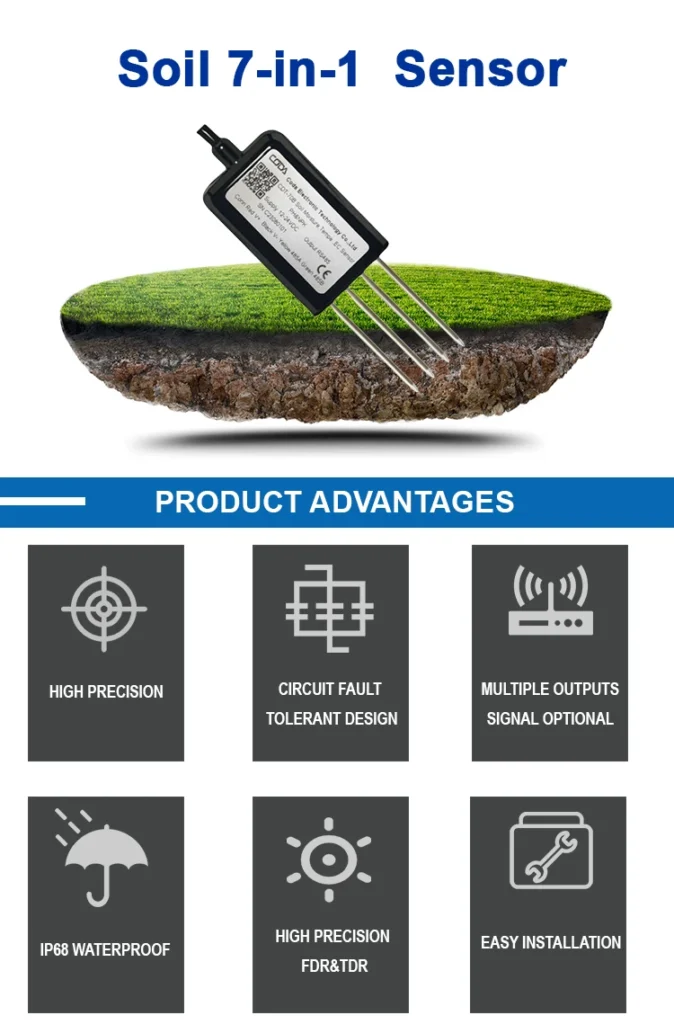Soil NPK Sensor: Definition, Working Principles, and Applications
Soil NPK sensors are new tools for farmers. They help check and analyze key nutrients in the soil. The main nutrients are nitrogen (N), phosphorus (P), and potassium (K).
By carefully measuring the levels of these nutrients, farmers can make smart choices about fertilization. This leads to better crop growth and higher yields. By carefully measuring the levels of these nutrients, farmers can make smart choices about fertilization. This leads to better crop growth and higher yields.
This article will explain sensors for soil. It will describe how they work and how farmers use them. We will look at their uses in different farming situations.
Part I: Understanding a soil NPK sensor
NPK sensors are tools that check key nutrients in the soil. These nutrients are nitrogen (N), phosphorus (P), and potassium (K).
These sensors check nutrient levels by putting electrodes right into the soil. Nitrogen, Phosphorus, and Potassium are key nutrients for plants. It is important to know the right amounts of these nutrients for healthy crop growth.
Soil sensors use different technologies to measure nitrogen, phosphorus, and potassium levels in the soil. This gives real-time information about soil nutrition.
Part II: The working principle of soil NPK sensors
Soil sensors mainly use light analysis and chemical methods to work. They also use special sensing techniques that focus on ions.
1. Spectral analyzing: This measurement method checks the amounts of N, P, and K in the soil. It does this by measuring how much light soil samples take in or bounce back at specific wavelengths.
Different nutrients absorb or reflect light in their own ways. This happens in the visible, near-infrared, or infrared ranges. We can find their amounts using special analysis methods.
2. Electrochemical: This method uses electrodes to check ion levels in the soil. It looks for ions such as nitrogen, phosphorus, and potassium. Sensors check nutrient levels by placing an electrode in the soil. They use a special process for this.
3. Ion selective sensing: This method uses special materials or membranes. They can attract or push away certain ions. This helps check the nutrient levels in the soil.
Soil NPK sensors are compared to a reference solution. They create an electrical signal or a chemical reaction. This helps them show data about nutrient levels.
Part III: Applications
Farmers use soil NPK sensors in many ways in farming. Here are some main areas where they are used:
Fertiliser management: Sensors help farmers check nutrient levels in the soil. This lets them use fertiliser wisely based on the results.
By checking the N, P, and K levels in the soil in real time, farmers can adjust their fertilizer use. This helps them save fertilizer and reduce pollution. As a result, crop growth and yield improve.
2. Evaluating soil health: Sensors are key in checking soil health. They track nitrogen, phosphorus, and potassium levels. Farmers can easily spot when nutrients are too low or too high. This helps them act to make the soil better.
3. Agricultural management: Sensors help farmers make their farms better. They give real-time data about nutrients. Farmers can use this data to adjust their work.
We need to change how we water plants, use fertilizer, and trim them. These changes improve crops and boost their yield.
4. Improving planting strategies: Soil sensors provide details about nutrients in the soil. This improves how we plant. Farmers can make planting plans based on the needs for nitrogen, phosphorus, and potassium in crops. This helps them use soil resources better and increase crop yields.
5. Environmental conservation: Soil sensors help cut down on nutrient loss from using too much fertilizer. This cuts down on pollution in water and the environment.
Farmers can check the N, P, and K levels in the soil. This helps them use fertilizers more wisely. This lowers environmental risks and supports sustainable farming.
Conclusion:
NPK soil sensors play a key role in farming. They help monitor and analyze key nutrients in real-long time. These nutrients are nitrogen, phosphorus, and potassium.
By measuring these levels correctly, farmers can change their fertilizer plans. This helps improve crop growth and yield.
These sensors can be very useful in many fields. They can help with fertilizer. They check soil health and monitor farms.
And they also plan planting and protect the environment. Knowing how they work and what they are used for can help improve farming and support sustainable land management.
